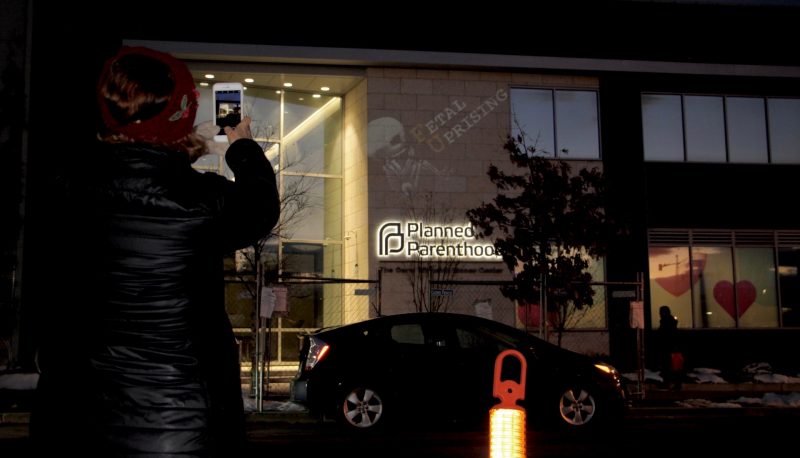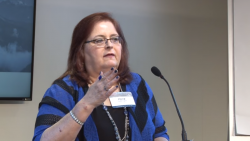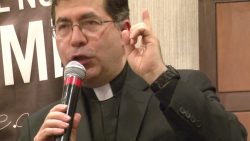Update 3/31/22: The Department of Justice announced the indictment of nine people Wednesday in connection to a “clinic invasion” of a Washington, D.C., reproductive health care center in 2020. On Thursday, the FBI found five fetuses in the Capitol Hill home of one of those charged: anti-abortion activist Lauren Handy. Robin Marty wrote about Handy and the radical anti-abortion activist movement of which they are a part in this 2019 report. This report has been updated to reflect that Handy identifies as nonbinary today and now uses they/them pronouns.
It was bitterly cold, even for January. A frigid wind cut through my cloth gloves as the sun slowly dipped behind the white stone façade of Planned Parenthood’s Carol Whitehill Moses Center in Washington, D.C. The clinic, which offers abortions and other health-care services to patients in the nation’s capital, had already closed for the day. The guards were gone from the entrance; the clinic escorts–volunteers dressed in bright vests, who help patients navigate the continent of protesters who customarily greet them—had all gone for the day. Instead, a glance through the glass doors showed a lone security person inside, likely remaining on duty until all of the staff and patients left for the evening.
Lauren Handy, a 25-year-old anti-abortion activist, waved at the man at the desk, calling out to him by name. He ignored them as if it were his job—which, for the most part, it was. As a graduate and current alumni organizer of the youth-oriented group, Survivors of the Abortion Holocaust, Handy is a familiar presence in the clinic’s neighborhood.
The D.C. Planned Parenthood building is always the center of bustling activity during the days surrounding the March for Life, an annual gathering where tens of thousands of abortion opponents—many of them high school- and college-aged—are bused in from around the country. When the clinic moved locations three years ago, reopening across the street from a neighborhood elementary school, the activists moved with it, bringing with them their annual protest welcoming the out-of-towners, which they conduct the day before the march itself.
As Handy wrestled with their skirts against the wind and the pile of equipment at their feet, two large coach-style buses pulled up in front of the clinic and young people poured out from the open doors. Bundled against the unaccustomed cold, roughly 50 high school students from Baton Rouge, Louisiana, lined the edges of the sidewalk directly across the street from the clinic—careful to leave the sidewalk itself open for foot traffic—silently standing as a priest offered a “Hail Mary” and “Our Father.” Just minutes later the students turned and left to re-board their buses, their vigil over as quickly as it had begun.
Any one of those students could easily be the next Lauren Handy. Like them, Handy also made the trek to D.C. from Baton Rouge this year to attend the March for Life. But unlike the shivering students bounding from the buses in their matching white stocking caps and bright green scarves, Handy wasn’t in D.C. for camaraderie, or to merely celebrate the wins that the anti-abortion movement had seen in the two years that Republican President Donald Trump had been in office, or to simply cheer on the possibility that the United States may be just a year or two from overturning the Supreme Court decision, Roe v. Wade, which would send the right to a legal abortion back to each state to decide.
No, Handy was in town to end abortion completely, through whatever means possible.
The Survivors of the Abortion Holocaust could in many ways be thought of as the “farm team” of the radical anti-abortion activist movement. Officially launched in 1998 by Jeff White, a former Operation Rescue leader from California, Survivors quickly became the go-to place for young activists interested in learning how to hone their skills in abortion debate, protesting in public spaces and asserting their First Amendment rights while doing both. Deeming anyone born after 1973—the year that the Supreme Court decided Roe—to be a “survivor” because they were born after abortion was deemed a federally protected constitutional right, Survivors accepts anyone between the ages of 13 and 29 into the fold for camps and trainings.
Many of those who attend these events are children of anti-abortion activists, or friends of children who already attended. Most new recruits come to Survivors via personal referrals. According to their website, in the roughly two decades that Survivors has been operating “hundreds” of Survivors have gone through the camp, with a number of them eventually moving on into leadership in other anti-abortion organizations, or even starting their own.
For example, Keith Mason, a former Survivor, founded Personhood USA, the Colorado anti-abortion group best known for its repeated efforts to try to get the state voters to approve an amendment stating life begins at conception. Abortion-Free New Mexico, the southwestern organization dedicated to trying to shut down later abortions in Albuquerque, is led by Bud and Tara Shaver, both graduates of the Survivors. Stanton Healthcare, the growing network of antiabortion pregnancy and sexual health centers hoping to be the next “pro-life Planned Parenthood” (without offering any form of contraception) is the project of another Survivor, Idaho’s Brandi Swindell. Stand True, the national youth ministry arm of Priests for Life, was founded by Bryan Kemper, who not only was recruited by White while Operation Rescue was still in at its peak influence, but has continued to partner with White ever since, including assisting in Survivor trainings as a mentor.
White’s founding of Survivors wasn’t the first attempt to recruit and weaponize younger activists for the abortion battle. For much of its history, Operation Rescue National included a youth ministry that continued even during its breakup and reorganization and eventual name-change to Operation Rescue/Operation Save America.
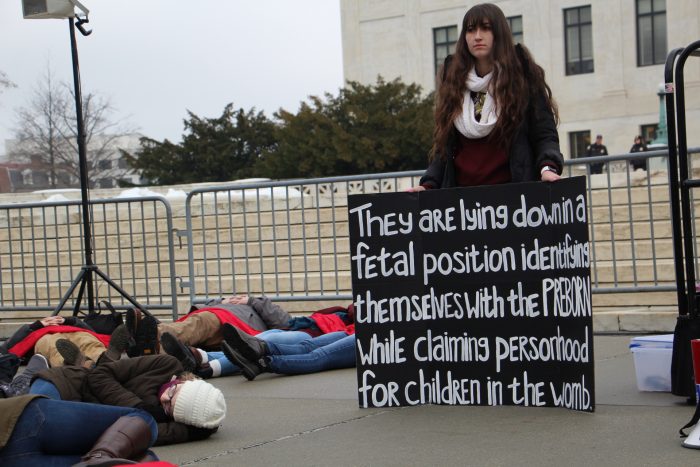
Another youth-oriented anti-choice group was CALL (Collegian Activated to Liberate Life), an organization that was active in the 1990s, which encouraged students to dedicate one year of their education to living in a communal home and working to end abortion in their local areas. This quest involved everything from sidewalk chalking anti-abortion messages on sidewalks and holding “die-ins”—a form of activism where students lay on the streets in the fetal position, draped in red cloth—to protesting pro-choice speakers or picketing at abortion clinics, or even “rescuing”—blocking clinic entrances or other avenues to ensure doctors and patients were unable to enter buildings to terminate a pregnancy. Rock for Life and Generation Life also worked to recruit students into the movement, all hoping to bring more younger activists to the cause that began as being historically dominated by the elderly.
“Back in those days [the 1970’s and 80’s], you know what we called a pro-life rally with 50 year olds? A youth rally,” Reverend Pat Mahoney quipped to me as we waited for a “die in” to begin at the Supreme Court. Mahoney, a longtime activist and one of the founders of CALL, still continues to work as an organizer in the pro-life youth movement.
In 1994 the Freedom of Access to Clinic Entrances (FACE) Act prevented the movement from conducting the “rescues” that had become synonymous with pro-life activism, and which by this point had evolved from crowds of protesters blocking clinics with their bodies to include smaller groups that chained themselves to doors, cement blocks, broken-down vehicles and, of course, each other, in order to make their removal from clinic sites all the more difficult. At the height of the “rescue” movement, clinics could be closed for hours or even days because of anti-abortion protesters sitting by the hundreds in doorways, surrounding the cars of providers so they couldn’t leave their homes to get to the clinics where they worked, or even rushing inside and breaking equipment like the suction machines commonly used in abortion procedures.
Born after the FACE Act took effect with its new limitations on anti-abortion protesting, leaders of Survivors of the Abortion Holocaust had to decide where this new line was drawn between impeding clinic access and expressing a First Amendment right to protest. Once they established parameters, they would train future anti-abortion leaders to push that line as far as they possibly could. The die-ins popularized by CALL became a favorite Survivor tactic, and while abortion opponents could no longer directly block clinics, they could still protest in front of them on public sidewalks and easements. They also concentrated on protesting the homes of abortion providers themselves, a tool that lost popularity among other anti-abortion activist groups after a streak of violence against abortion providers in the mid-1990s. Meanwhile, the group also trained and unleashed the new Survivors in the streets in an effort to change the public’s mind on abortion one person at a time, using graphic signs and street displays to draw bystanders in, to be treated to the young activists’ newly learned talking points.
Survivors quickly became known for their in-your-face confrontations, tactics that sometimes badly hurt their movement. In 2013, when the city of Albuquerque, New Mexico, considered a ballot measure that would forbid abortion after 20 weeks of pregnancy, Survivors swarmed the city to rally support for the ban. One day they protested the home of a local doctor who was providing these later abortions, terrifying the practitioner’s wife, who called the police to disperse them. The Survivors activists—mostly teens—passed out postcards with the names and photos of doctors doing later abortions in the city, calling them the “Killers Among Us.” They even took their large graphic images of fetal remains to the local Holocaust Museum in an effort to engage voters and solicit media attention.
They got the attention, but it didn’t translate into support at the polls. The ballot measure failed 55-44, with pundits pointing to “overzealous” abortion opponents as a key factor in the loss.
Then again, winning legislative victories isn’t a primary goal of Survivors, who believe that it takes direct action and agitation to ensure that America wakes up from its complacency about the existence of legal abortion. It’s for that reason that the group increasingly focuses on actions that don’t just make abortion supporters uncomfortable, but sometimes their own allies, too. Graphic fetal images displayed outside of schools or in other public areas where young children might see them is one topic of disagreement. Another is over giving the young people in their ranks—many of them minors—the autonomy to run their own protests and actions, even if they are toeing the line of legality under the FACE Act. When it comes to protesting clinics or other public actions, the Survivors trainees are in charge of the mission. That could mean having 13-year-old children not only participating in protests, but often serving as media spokespeople and police liaisons, too.
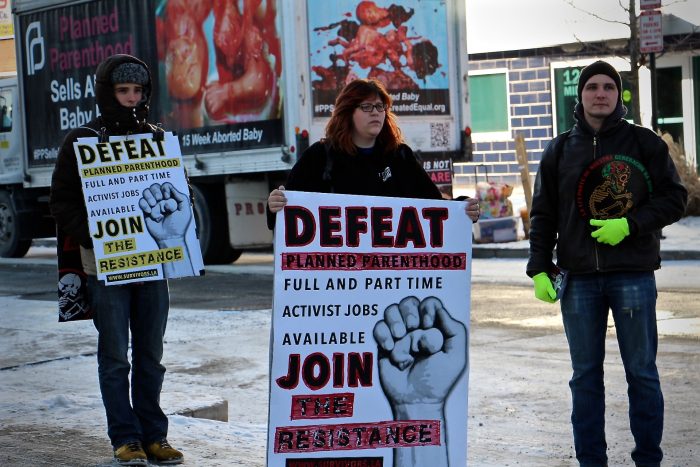
The tactics used by Operation Rescue are based around the notion that fertilized eggs, embryos and fetuses are “babies” whose lives can be “rescued” if abortion clinics are unable to serve patients. Activists who deploy such tactics as clinic barricades are said to be conducting “rescues.” According to Handy, Survivors doesn’t train their campers to revive “rescue” tactics per se, but they do make sure they are aware of the rescue movement’s history. They are now also adding in the newly launched Red Rose Rescues, a more moderate, less blatantly FACE-violating form of “rescue,” where activists enter clinics carrying roses, urge patients to leave, and refuse to exit the clinic until police physically remove them from the building. As for whether that could be seen as encouraging a new generation of potential lawbreakers, well, that’s up to the recruits themselves.
“Of course, because they’re kids, they like the war stories,” Handy tells me. “They get hyped up and everything like that. Red Rose Rescue, it’s really sparked the spirit of rescue again. That hope of doing a tangible, sacrificing witness—kids who are so passionate, they’re drawn to that. They need an outlet, a physical outlet, and there’s only so much protesting [in a legal manner] can do.”
So does Handy believe in encouraging teens to violate the FACE Act? When I ask them, they pause for a few seconds. “Oh gosh, you’re going to quote me on this,” they say, hesitating, then adds in a rush, “Whatever. I believe minors should rescue because at 18 the records get sealed.”
Handy’s belief in letting minors take the lead on actions that could potentially lead to arrest isn’t uncommon in the movement. “Children’s Rescue” was a regular component of pre-FACE “rescues,” one that was particularly effective because of police officers’ discomfort with arresting and physically removing minors from a clinic. The fact that so few people are currently advocating for minors to undertake full-fledged “rescues” in order to test out the Trump administration’s stance on upholding FACE might be the biggest sign that abortion opponents believe they are on the verge of winning the battle to end legal abortion. After all, why poke an administration that is already so obviously in your favor?
Handy joined the Survivors herself when they were 19, already too late to avoid the advantages of stretching the boundaries of the law as a minor. In 2015, they was arrested in Washington, D.C., with a handful of other activists for refusing to leave the entrance to the office of then-Speaker of the House John Boehner, after the Republican leader refused to hold a House vote on a bill which would have banned abortion throughout the nation after 20 weeks post-fertilization, with no exceptions for sexual assault or fetal anomalies. More recently, Handy was arrested for their part in a Red Rose “rescue” in Washington, D.C., another in Alexandria, Virginia, and then yet another D.C. “rescue” just this March. So far none of Handy’s arrests have resulted in jail time, but should that be their fate, they are not daunted by the idea. “It would be a great time to start a prison ministry,” Handy said.
That’s not an unusual outcome for “rescuers” who land in jail. According to Handy, White himself ran Operation Rescue National for six months out of a jail kitchen while serving one of the many sentences he racked up as a prominent anti-abortion organizer. And he very well may end up running Survivors from there, too. In October of 2018, White accepted a plea deal for defrauding the federal government of $27 million through illegal drug rehabilitation program enrollments, a scheme which allegedly netted White between $3,000-$7,500 per patient in kickbacks; White is facing five years in prison for his actions. While he admits his guilt, both he and his supporters argue that his motivation was primarily to help homeless addicts get the help they needed—and to take advantage of a government program to foot the bill.
“I believe it’s a form of rescue in itself,” Handy explained, saying that White’s actions are similar to a “Robin Hood” situation: Robbing the rich to help the poor. “He was using that money to… make sure people could get into rehab. Basically finding loopholes to ensure people can get quality healthcare. I always call him the Robin Hood, especially in this sense. Yeah, screw over the rich to help [poor people]. I have no problem with that, but some people think it looks like he tarnished the movement, and people have distanced themselves from us. I mean that’s their decision and that’s what people live with. But Survivors are survivors. I mean, would you expect anything less?”
Although the prospect of going to jail doesn’t seem to frighten Survivors, the vast majority of their current agitation campaigns are more guerrilla tactic than FACE-challenging. Legal or not, they definitely draw attention—along with the ire of pedestrians, clinics and police.
As Handy struggled with a projector they intended to use to splash text and images on the Planned Parenthood building, I watched them suddenly jump up to dash after one woman who emerged from the clinic doors.
“You don’t have to work here!” Handy shouted. “I don’t work there, bitch!” the woman retorted, speed-walking down the sidewalk away from us.
“She works here,” Handy told me in a conspiratorial tone, settling back down with their projector.
While I spent the evening in the cold with Handy and two other activists (who were not current or former Survivor members), it was evident that no one was happy with the projections Handy was trying to display on the Planned Parenthood clinic walls.
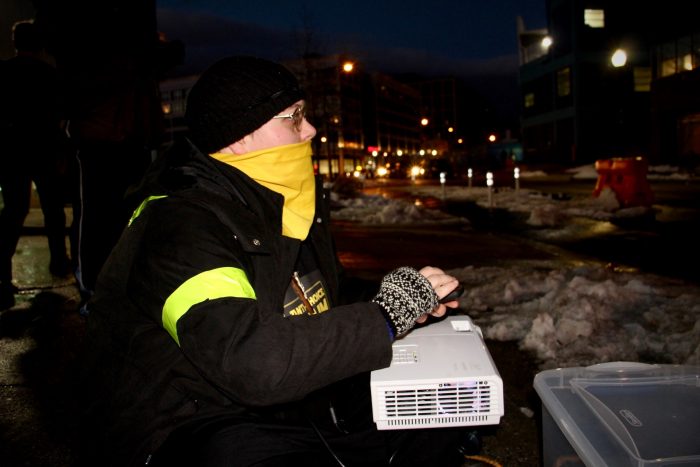
Once it became clear that Handy was too close to the building for the projections to be effective, they crossed the street to try again. Careful not to block the sidewalk, which they knew would be a violation, Handy moved her equipment into the edge of the street to position the projector. A young man walking by who appeared to be in his 20s approached Handy and demanded that they move.
“This is a bike lane. You can’t be here,” he told Handy.
We hadn’t seen a bike come through in the hour we had been outside.
“Thanks for letting us know,” one of Handy’s companions told him, turning back to the machine.
The objector stepped even closer. “You have to move. This is a bike lane. You have to keep it clear for bikes.”
The three activists thanked him again and continued to ignore him.
After a few minutes of continuing to tell them to get out of the bike line, the man then jumped in front of Handy’s projector, blocking the image from the walls. A small, white-lit fetus now appeared on his red jacket as he jumped up and down in front of Handy’s machine.
Hoping to defuse the confrontation, I asked the agitated passerby if he would come talk to me for a second, to which he reluctantly agreed. “I think I can get them to move, but I need you to leave or they won’t do it,” I told him, explaining that I wasn’t with the group but might be able to sway them regardless. He agreed, then threw a dirty look at Handy and left.
Handy moved her equipment out of the lane once he was gone. “I just really don’t like people thinking they can tell me what to do, and be rude about it,” they said, smiling.
It was clear that this was the sort of reaction that Survivors are used to. Soon after, another man who appeared to live in the neighborhood came to argue about abortion with the anti-abortion activists, who by this point had been joined by two Red Rose Rescuers, too. Voices grew louder on both sides as two men went in circles over the right to life and the obligation of a woman to remain pregnant if she conceives.
Soon a police car pulled up next to us. “What’s going on here?” an officer asked as he stepped out of the vehicle.
“We are just here expressing our First Amendment rights,” Handy responded, as their companions took out phones to record any possible confrontation.
“And how long exactly do you plan to be doing this for?” he asked.
“Probably another 30 minutes,” Handy answered.
As the officer got back in his car, they leaned over and told me, “The clinic called them on us.” Handy claims that having the police called on them is a regular occurrence when they are around a facility that provides abortion services.
The clinic building was now awash in glowing images: “Planned Parenthood Is Evil,” “Planned Parenthood is Bad Business,” “Fetal Uprising” (with a picture of a skeletal fetus curled beside the text). After 30 minutes of projector-messaging, the group was ready to move on to a new location, this time far away from any abortion clinics.
“Survivors are the Marines of the pro-life movement,” Handy told me. “First ones in, last ones out.” And at the Planned Parenthood, you can be certain staff, neighbors and police were all glad to see them finally go.




